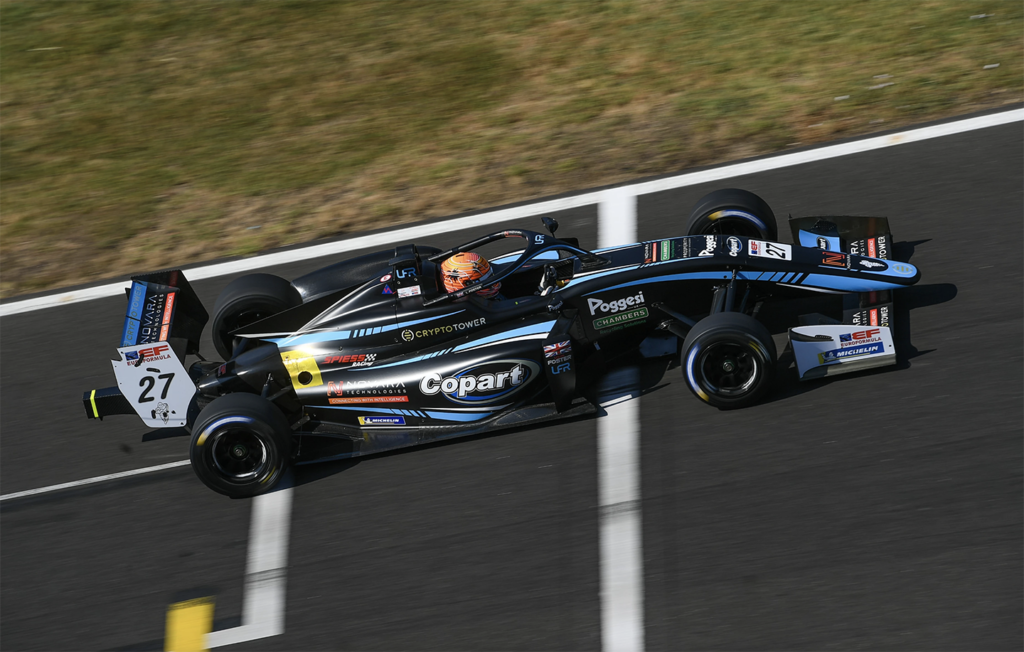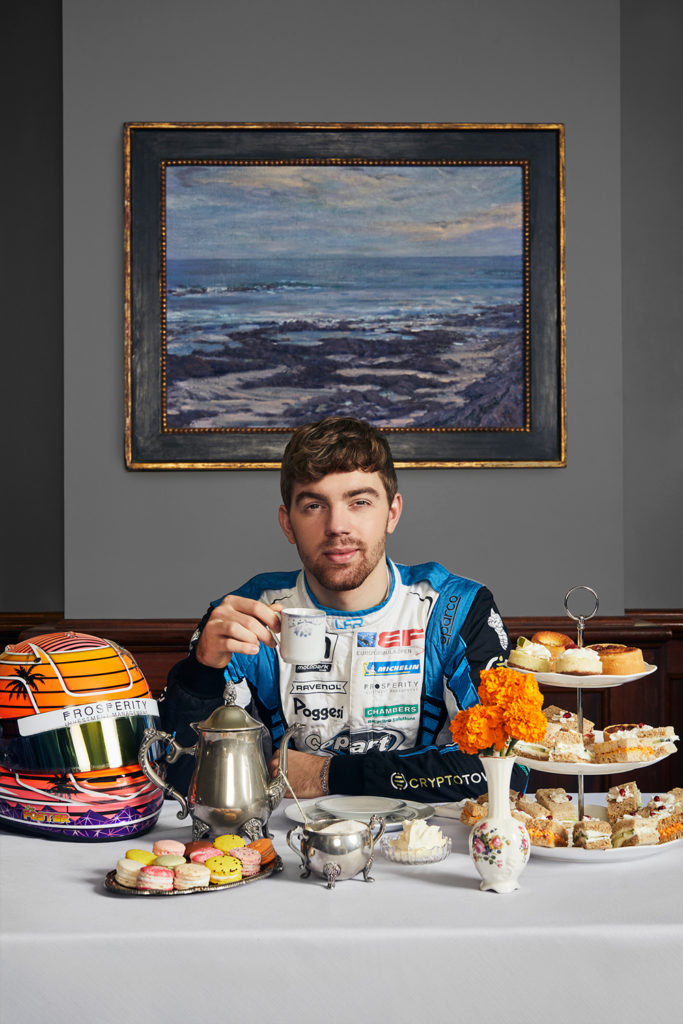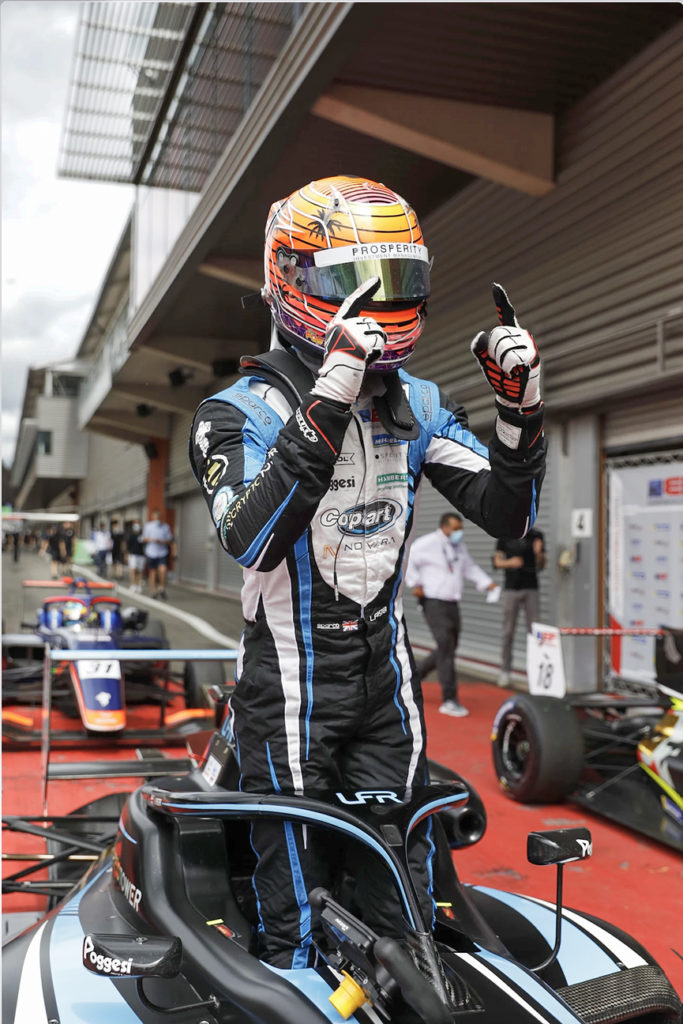
LMU Magazine: Let’s cut to the chase. Why did you choose to come from the United Kingdom to the United States — and to LMU?
My end goal is to race IndyCar [the premier open-wheel racing series that includes the Indianapolis 500], so I knew I would have to be racing in the States, and I decided I should continue my studies here, too.
I chose LMU because of its location and community feel. Everyone is really friendly and welcoming. The business program is really good, and I would like to start my own company, if I’m not racing. I stepped on campus for the first time in September, and I really like the smaller classes and being able to go more in-depth with the professors.
So your racing goals drove the decision. For those who don’t follow the sport, describe the type of racing you do.
Here in the States, when most people think of racing they think of NASCAR, which is oval racing — they drive around in a circle, and the car looks a bit like a road car. What I’m doing is called Formula single-seater driving. We don’t do oval racing; we do road or street racing around circuits, which turn left and right. The cars I drive look a bit like spaceships — the wheels stick out, and they have a front and rear wing. You can see the driver’s head because it’s an open cockpit. They’re ridiculously fast around corners.
An open cockpit sounds ridiculously dangerous as well.
It does make it more dangerous because there can be debris flying at the car if there is an accident. In a normal car, you’ve got a windshield, but in these cars, that stuff can hit your head. Obviously, you’ve got a helmet, but there are some things that a helmet can’t protect against. You’re a lot more open to the elements. It can be scary at times.
The United Kingdom is the home of motor sport.

Talk about the fear factor. How do you handle it?
There are times I have been scared, especially in certain conditions — when it’s extremely wet, or visibility is poor, or when you’re hydroplaning and the car could snap out from underneath you at any moment. With time, the fear becomes more second nature. You need to have a certain mentality. You can’t compete at the highest level whilst thinking about crashing into a wall and getting hurt or dying. You can’t think about it that way because then you won’t be fast.
Have you had any close calls?
There was one crash when my brakes failed going into a corner, and my front wing dug into the ground and split off the car and went over my head by about 2 centimeters. At the time you can’t see because you’re going so fast. But when I watched the video, I saw how close the wing was to my head.
I haven’t had too many accidents — mostly into walls, which is usually OK at certain speeds. It’s quite a scary feeling when you know you’re about to crash, and it’s too late to do anything about it — what has happened has happened. It all goes slow motion, and you can see yourself going toward the barrier or another car, and you have to take your hands off the steering wheel and brace and hope it doesn’t hurt. It can knock the wind out of you. I still have back issues from a crash three years ago.
You’re too young for back issues. Given the dangers, why do it? What do you love about it?
It’s something that you can’t get anywhere else. There is no other sport like it. You’re driving these beasts that go ridiculously fast, that you’re controlling. It’s something you can’t really describe unless you do it. You and the car become one, and you enter a state of flow. The wind rushing past your ears, the noise, the engine revving — it’s extremely raw. And it may seem like a very aggressive thing to do — the power, the speed — but it’s actually also very delicate. You’re thinking about brake points, turning points, threading the wheel through corners, slowly squeezing off the brake, and really controlling the car with all the tools you have.
So, that’s why I do it. It satisfies something that nothing else can.
How did you get started?
My family is a racing family, and the United Kingdom is the home of motorsport. My granddad was one of the people who wrote the first-ever rulebook for kart racing back in the 1950s. And my dad raced. When I was 5 years old, he brought me and my brother to the local kart track. It was a fun family thing we did on the weekends. Once he realized that I was decent at it, we decided to progress it further. He’s been a massive influence.
162 miles an hour is fast, but it’s not gob-smacking fast.

Talk about the commitment — the time and work that goes into racing.
It’s extremely intense. When we practice, we call it testing. You test a circuit prior to the event — like a scrimmage a team would have. But it’s not like you can walk to the local field and throw around the football. You’ve got to travel to test. In the past month, I’ve been in Austria and Milan. Next month, I’ll be in Indiana, the U.K., Barcelona, back to the U.K., Indiana again, then Chicago and then back to L.A.
It sounds like you do a lot on the fly, literally. How do you manage all the travel and being a full-time student?
You can’t be unorganized and do this. I have no free time. That’s the sacrifice of doing racing. I have long flights, especially the transatlantic ones, so I get everything downloaded that I need prior to getting on the plane. In this semester so far, I’ve done 44 hours of flying — four 11-hour flights — so it’s book open, study the entire flight, and when the plane lands, book shut. It’s difficult to do work in the hotel after racing because you’re extremely tired, but you can watch some videos and take notes. You have to be very organized and dedicated to both, otherwise it can’t be done.
Are you able to enjoy and explore these destinations or is it all about the racing?
These are lovely places. Budapest, Milan, Barcelona. But I land, go straight to the track, do four hours of preparation for driving — every day, hotel to track to hotel to track. And the last day you go track to airport. Sometimes you have a dinner and experience a bit. But at the end of the day, racing is its own bubble, so you don’t really get to visit. Racing is no longer a hobby for me; it’s a job.
How fast can your car go?
This year we topped 162 miles an hour. But the thing about my car is not the straight-line speed — 162 miles an hour is fast, but it’s not gob-smacking fast. The thing that makes my car special is the corner speed. With the aerodynamics on the car, it’s a bit like an airplane in reverse. A single-seater F3 car is built to be pushed down, to give it grip, and that allows you to go into corners at over 100 miles an hour.
Wow. Talk about the physical demands of driving?
It really puts a strain on your body. Every time you go through a corner, you’re pulling a certain amount of G-force. When I turn into a right corner at 90 miles an hour, my body wants to go left, so you have to have core and neck strength to do that. The average head weighs 4 to 5 kilograms; when you go into a corner at 90 miles an hour, it weighs up to 20 kilograms. You also have to have grip strength to steer — there’s no power steering, it’s just you and the car. And it gets extremely hot in the car. You’re wearing a fire-retardant race suit that is heavy. You’re sweating. You’re sitting on top of a fuel tank, which is quite hot. All of those factors combine to create fatigue. So, a lot of my training is cardiovascular, long-endurance training.
You can’t compete at the highest level whilst thinking about crashing into a wall and getting hurt or dying.
How well did you do this year?
We had a very strong performance. One weekend we won all three races — one of only four drivers to ever do that. And I’ve been selected as a finalist for the 2021 Aston Martin Autosport BRDC Young Driver of the Year Award. [The award will be announced Feb. 6, 2022.] But this year was about learning and getting to where I want to be: an IndyCar champion. At the end of the day, whether or not I win, the result is valued less to me than how much I learn.
That prestigious award includes a £200,000 prize — nice, as racing is not inexpensive.
Racing is one of the most expensive sports to compete in. Fortunately I’m lucky to have amazing sponsors that support me, including Carport Racing here in the States. I couldn’t do it without them. I work with sponsors to give them value for what they give me, whether it’s a sticker on the car, or meeting with employees they bring to watch a race. That’s how it works. A professional driver has to be many things. You can’t just drive cars fast. You have to be intelligent, presentable and good with people. I was 14 years old when I started walking into rooms full of business owners and talking with them. The reality is racing wouldn’t exist without sponsors and spectators. For example, if the NBA wasn’t a thing, people would still play basketball. Without spectators and sponsors, there would be no racing. So, you have to build relationships with them.
Aaron Smith is a Los Angeles-based writer and frequent contributor to LMU Magazine. “Nature Nurture,” his interview with Wendy Butts, MBA ’00, CEO of the LA Conservation Corps, appeared in the winter 2020 issue of LMU Magazine. His “No One Left Behind” is feature story about the 1950 Loyola University football team that refused to play a game in Texas when the university learned the opponent’s policies did not permit team’s Black players to take the field. The story appeared in the summer 2010 issue (Vol. 1, No. 1) of LMU Magazine.
